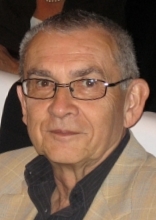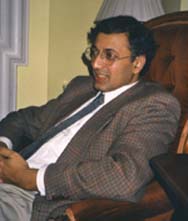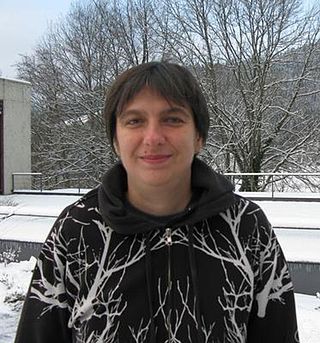Related Research Articles

Alain Connes is a French mathematician, known for his contributions to the study of operator algebras and noncommutative geometry. He is a professor at the Collège de France, Institut des Hautes Études Scientifiques, Ohio State University and Vanderbilt University. He was awarded the Fields Medal in 1982.
Noncommutative geometry (NCG) is a branch of mathematics concerned with a geometric approach to noncommutative algebras, and with the construction of spaces that are locally presented by noncommutative algebras of functions, possibly in some generalized sense. A noncommutative algebra is an associative algebra in which the multiplication is not commutative, that is, for which does not always equal ; or more generally an algebraic structure in which one of the principal binary operations is not commutative; one also allows additional structures, e.g. topology or norm, to be possibly carried by the noncommutative algebra of functions.
In differential geometry, the Atiyah–Singer index theorem, proved by Michael Atiyah and Isadore Singer (1963), states that for an elliptic differential operator on a compact manifold, the analytical index is equal to the topological index. It includes many other theorems, such as the Chern–Gauss–Bonnet theorem and Riemann–Roch theorem, as special cases, and has applications to theoretical physics.
In theoretical physics, the matrix theory is a quantum mechanical model proposed in 1997 by Tom Banks, Willy Fischler, Stephen Shenker, and Leonard Susskind; it is also known as BFSS matrix model, after the authors' initials.
In noncommutative geometry and related branches of mathematics, cyclic homology and cyclic cohomology are certain (co)homology theories for associative algebras which generalize the de Rham (co)homology of manifolds. These notions were independently introduced by Boris Tsygan (homology) and Alain Connes (cohomology) in the 1980s. These invariants have many interesting relationships with several older branches of mathematics, including de Rham theory, Hochschild (co)homology, group cohomology, and the K-theory. Contributors to the development of the theory include Max Karoubi, Yuri L. Daletskii, Boris Feigin, Jean-Luc Brylinski, Mariusz Wodzicki, Jean-Louis Loday, Victor Nistor, Daniel Quillen, Joachim Cuntz, Ryszard Nest, Ralf Meyer, and Michael Puschnigg.

Yuri Ivanovich Manin was a Russian mathematician, known for work in algebraic geometry and diophantine geometry, and many expository works ranging from mathematical logic to theoretical physics.

Daniel Kastler was a French theoretical physicist, working on the foundations of quantum field theory and on non-commutative geometry.
In theoretical particle physics, the non-commutative Standard Model, is a model based on noncommutative geometry that unifies a modified form of general relativity with the Standard Model.
In mathematics, specifically in operator K-theory, the Baum–Connes conjecture suggests a link between the K-theory of the reduced C*-algebra of a group and the K-homology of the classifying space of proper actions of that group. The conjecture sets up a correspondence between different areas of mathematics, with the K-homology of the classifying space being related to geometry, differential operator theory, and homotopy theory, while the K-theory of the group's reduced C*-algebra is a purely analytical object.
In mathematics, the field with one element is a suggestive name for an object that should behave similarly to a finite field with a single element, if such a field could exist. This object is denoted F1, or, in a French–English pun, Fun. The name "field with one element" and the notation F1 are only suggestive, as there is no field with one element in classical abstract algebra. Instead, F1 refers to the idea that there should be a way to replace sets and operations, the traditional building blocks for abstract algebra, with other, more flexible objects. Many theories of F1 have been proposed, but it is not clear which, if any, of them give F1 all the desired properties. While there is still no field with a single element in these theories, there is a field-like object whose characteristic is one.
In mathematics, the Butcher group, named after the New Zealand mathematician John C. Butcher by Hairer & Wanner (1974), is an infinite-dimensional Lie group first introduced in numerical analysis to study solutions of non-linear ordinary differential equations by the Runge–Kutta method. It arose from an algebraic formalism involving rooted trees that provides formal power series solutions of the differential equation modeling the flow of a vector field. It was Cayley (1857), prompted by the work of Sylvester on change of variables in differential calculus, who first noted that the derivatives of a composition of functions can be conveniently expressed in terms of rooted trees and their combinatorics.
In noncommutative geometry and related branches of mathematics and mathematical physics, a spectral triple is a set of data which encodes a geometric phenomenon in an analytic way. The definition typically involves a Hilbert space, an algebra of operators on it and an unbounded self-adjoint operator, endowed with supplemental structures. It was conceived by Alain Connes who was motivated by the Atiyah-Singer index theorem and sought its extension to 'noncommutative' spaces. Some authors refer to this notion as unbounded K-cycles or as unbounded Fredholm modules.

Shahn Majid is an English pure mathematician and theoretical physicist, trained at Cambridge University and Harvard University and, since 2001, a professor of mathematics at the School of Mathematical Sciences, Queen Mary, University of London.

Matilde Marcolli is an Italian and American mathematical physicist. She has conducted research work in areas of mathematics and theoretical physics; obtained the Heinz Maier-Leibnitz-Preis of the Deutsche Forschungsgemeinschaft, and the Sofia Kovalevskaya Award of the Alexander von Humboldt Foundation. Marcolli has authored and edited numerous books in the field. She is currently the Robert F. Christy Professor of Mathematics and Computing and Mathematical Sciences at the California Institute of Technology.

Joachim Cuntz is a German mathematician, currently a professor at the University of Münster.
Georges Skandalis is a Greek and French mathematician, known for his work on noncommutative geometry and operator algebras.

Guoliang Yu is a Chinese American mathematician. After receiving his Ph.D from SUNY at Stony Brook in 1991 under the direction of Ronald G. Douglas, Yu spent time at the Mathematical Sciences Research Institute (1991–1992), the University of Colorado at Boulder (1992–2000), Vanderbilt University (2000–2012), and a variety of visiting positions. He currently holds the Powell Chair in Mathematics and was appointed University Distinguished Professor in 2018 at Texas A&M University. He is a fellow of the American Mathematical Society.

Ralph Martin Kaufmann is a German mathematician working in the United States.
Jean Vincent Bellissard is a French theoretical physicist and mathematical physicist, known for his work on C*-algebras, K-theory, noncommutative geometry as applied to solid state physics, particularly, to quantum Hall effect.

Dan Burghelea is a Romanian-American mathematician, academic, and researcher. He is an Emeritus Professor of Mathematics at Ohio State University.
References
- ↑ Biographical information from Annual Report, Institute of Advanced Studies, 1980
- ↑ "Henri Moscovici". Department of Mathematics, Ohio State University. 2013-10-17.
- 1 2 Henri Moscovici at the Mathematics Genealogy Project
- ↑ "Alice Louise Ridenour Wood, Endowed Chairs, College of Arts and Sciences". Ohio State University. 2018-12-06.
- 1 2 Jackson, Allyn (2021). "Interview with Alain Connes". celebratio.org. Celebratio Mathematica . Retrieved February 24, 2022.
- ↑ Connes, Alain; Moscovici, Henri (1990), "Cyclic cohomology, the Novikov conjecture and hyperbolic groups" (PDF), Topology , 29 (3): 345–388, doi: 10.1016/0040-9383(90)90003-3 , Zbl 0759.58047
- ↑ Skandalis, Georges (2001). "Géométrie non commutative, opérateur de signature transverse et algèbres de Hopf (d'après Connes et Moscovici)" (PDF). Séminaire Bourbaki (892).
- ↑ Moscovici, Henri (1990). "Cyclic cohomology and invariants of multiply connected manifolds". In: Proceedings of the International Congress of Mathematicians. Vol. 1. pp. 675–688. CiteSeerX 10.1.1.466.1366 .
- ↑ "Distinguished Scholar Award". Ohio State University newspaper, onCampus online. Vol. 30, no. 21. 24 May 2001.
- ↑ Connes, Alain; Gorokhovsky, Alexander; Lesch, Matthias; Pflaum, Markus; Rangipour, Bahram, eds. (2011). Noncommutative Geometry and Global Analysis: Conference in Honor of Henri Moscovici, June 29–July 4, 2009, Bonn, Germany. Contemporary Mathematics. Vol. 546. Providence, RI: American Mathematical Society. ISBN 978-0-8218-4944-6. MR 2815127.
- ↑ "Mathematical Institute of the University of Bonn – Events". www.math.uni-bonn.de. Hausdorff Center for Mathematics . Retrieved February 23, 2022.